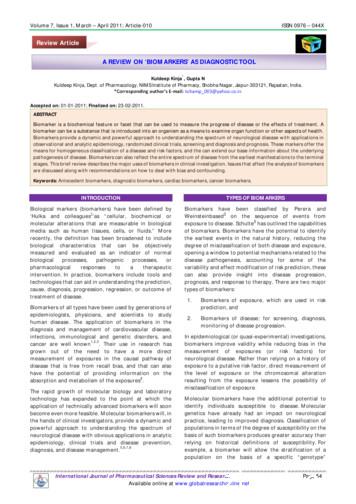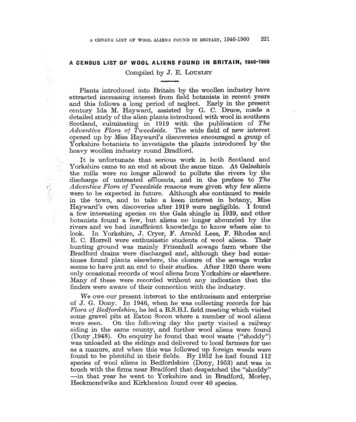Peripheral Immune-based Biomarkers In Cancer Immunotherapy .
Nixon et al. Journal for ImmunoTherapy of 19) 7:325REVIEWOpen AccessPeripheral immune-based biomarkers incancer immunotherapy: can we realizetheir predictive potential?Andrew B. Nixon1*, Kurt A. Schalper2, Ira Jacobs3, Shobha Potluri4, I-Ming Wang5 and Catherine Fleener6,7AbstractThe immunologic landscape of the host and tumor play key roles in determining how patients will benefit fromimmunotherapy, and a better understanding of these factors could help inform how well a tumor responds totreatment. Recent advances in immunotherapy and in our understanding of the immune system haverevolutionized the treatment landscape for many advanced cancers. Notably, the use of immune checkpointinhibitors has demonstrated durable responses in various malignancies. However, the response to such treatmentsis variable and currently unpredictable, the availability of predictive biomarkers is limited, and a substantialproportion of patients do not respond to immune checkpoint therapy. Identification and investigation of potentialbiomarkers that may predict sensitivity to immunotherapy is an area of active research. It is envisaged that a deeperunderstanding of immunity will aid in harnessing the full potential of immunotherapy, and allow appropriatepatients to receive the most appropriate treatments. In addition to the identification of new biomarkers, theplatforms and assays required to accurately and reproducibly measure biomarkers play a key role in ensuringconsistency of measurement both within and between patients. In this review we discuss the current knowledge inthe area of peripheral immune-based biomarkers, drawing information from the results of recent clinical studies ofa number of different immunotherapy modalities in the treatment of cancer, including checkpoint inhibitors,bispecific antibodies, chimeric antigen receptor T cells, and anti-cancer vaccines. We also discuss the varioustechnologies and approaches used in detecting and measuring circulatory biomarkers and the ongoing need forharmonization.Keywords: Biomarkers, Immunology, Immunotherapy, Oncology, Peripheral bloodIntroductionImmunotherapy represents a major breakthrough for anumber of cancers, but not all patients derive benefit,leaving many with an unmet need. When consideringthe immune composition of the tumor, factors such asthe amount, functionality, and spatial organization of infiltrated immune cells, particularly T cells [1], are established as important for immune checkpoint therapyresponses, for example. Other tumor factors associatedwith enhanced response to immunotherapy includemicrosatellite instability, tumor mutational burden(TMB) [2–4], and inflammatory gene expression [5].* Correspondence: andrew.nixon@duke.edu1Duke University School of Medicine, Department of Medicine/MedicalOncology, 133 Jones Building, Research Drive, Durham, NC 27710, USAFull list of author information is available at the end of the articleRecently, the analysis of TMB and T-cell gene expression provided value in identifying patients most likely torespond to pembrolizumab, suggesting the potentialvalue for these biomarkers in the selection of patientsfor checkpoint therapy [5].While tumor sampling is widely implemented for biomarker identification and analysis, obtaining tissue ischallenging because of limited accessibility, multiple lesions, heterogeneity of the biopsy site, and patient condition. Tumor biopsies are generally costly, invasive, causetreatment delays, and increase the risk of adverse events(AEs). Hence, analysis of readily accessible peripheralblood is critical for developing biomarkers with clinicalutility. Tumor genomic alterations such as discreteoncogenic variants (e.g. EGFR, PBRM1, LKB1, JAK1/2,and B2M mutations), complex rearrangements/copy The Author(s). 2019 Open Access This article is distributed under the terms of the Creative Commons Attribution 4.0International License (http://creativecommons.org/licenses/by/4.0/), which permits unrestricted use, distribution, andreproduction in any medium, provided you give appropriate credit to the original author(s) and the source, provide a link tothe Creative Commons license, and indicate if changes were made. The Creative Commons Public Domain Dedication o/1.0/) applies to the data made available in this article, unless otherwise stated.
Nixon et al. Journal for ImmunoTherapy of Cancer(2019) 7:325number variations (e.g. programmed death ligand 1/2[PD-L1/2] amplification), microsatellite instability, andTMB-related metrics can be detected in blood usingnext-generation sequencing (NGS) analysis of circulatingtumor DNA. Circulating tumor cells also demonstrateprognostic value as liquid biopsies in certain tumortypes such as breast and prostate, with measurementof nuclear proteins such as prostate cancer androgenreceptor splice variant-7, providing additional supportive information for prognosis and therapy selection [6]. For evaluation of peripheral immune-cellfunction, several immune-related analytes may bemeasured, including cytokines, soluble plasma proteins, and immune cells, analyzed by surface markerexpression, transcriptomic, or epigenetic profiles.Table 1 lists example technologies that may beemployed for the measurement of circulating biomarkers. Of these, RNA-seq, flow and mass cytometry, and enzyme-linked immunosorbent assay-basedmultiplex technologies are frequently utilized to identify peripheral immune markers associated with clinical response to immune modulating therapies.Many studies provide compelling evidence that peripheral immune fitness and status may aid in guidingtreatment decisions. Thus far, no US FDA-approvedcirculatory immunological biomarker has been validated for patients with cancer, and significant challenges exist in bridging the gap between identifyingsignatures correlated with response, and validatedprospective and predictive biomarker selection. As theimportance of biomarkers to guide therapies escalates,the need for proper analytical and clinical validationfor these biomarkers is paramount. Analytical validation ensures the biomarker technically performs forthe intended purpose and has reproducible performance characteristics. Once analytically validated, it canthen be evaluated for clinical utility where iterativetesting can link the biomarker to a biological processor clinical outcome. In order to adopt biomarkersmore quickly and effectively, this increased emphasison analytical and clinical validation is paramount. Interms of approaching biomarker development for peripheral cell analyses, pre-analytical considerationsaround collection methodology, vacutainer type, processing time, and storage conditions are key. Furthermore, differences in technologies, antibodies, anddevelopment of multiplex panels may lead to variability within these molecular correlates.This review focuses on key findings correlating peripheral blood immune biomarkers at baseline or on treatment with response to immunotherapies of variousmodalities, their associated methodologies, and emergingtechnologies showing promise for deeper profiling andinsights.Page 2 of 14Biomarkers and immunotherapy modalitiesPeripheral immune-based biomarkersSome important peripheral leukocyte subtypes demonstrating associations with responses to immunotherapyare shown in Fig. 1. Baseline or on-treatment frequencies of effector cells are often associated with positivetreatment outcomes, while high frequencies of inhibitorycells such as myeloid-derived suppressor cells (MDSCs)and regulatory T cells (Treg) often associate with poorerresponse. The specific cell types and kinetics of cell responses are inconsistent across studies, which may reflect differences in methodologies, sample matrix orassay reagents used, validation rigor, patient tumor stage,or prior and current treatments. Table 2 summarizessome key findings of reviewed literature regarding thecurrent landscape of predictive immune-based circulating biomarkers across immunotherapy treatmentmodalities.Checkpoint inhibitorsActivated, exhausted, and target-bearing lymphocytescan be assessed through multiparameter immunophenotypic analysis to facilitate patient stratification. Changesin biomarkers following initial treatment could also potentially screen for early response. For example, in patients with advanced cancer, responders showed a higherexpression of programmed cell death protein 1 (PD-1)on CD4 and natural killer (NK) cells than nonresponders after the first cycle of anti-PD-1 immunotherapy, with lower expression of T-cell CTLA-4,glucocorticoid-induced TNFR-related protein, and OX40after the second cycle. The elevation of key immunemetrics following the first cycle, with a decrease afterthe second, was associated with a better outcome at anearly treatment stage [24]. Tumor burden has beenshown to correlate with PD-1 expression on peripherallymphocytes, and PD-1 engagement in vivo can be measured on circulating T cells as a biomarker for responseto immunotherapy [7, 44]. Immune metrics currently associated with sensitivity/resistance to PD-1 blockers include early changes in peripheral T-cell proliferation [3]and serum levels of interleukin 8 (IL-8) [18]. Notably, asurrogate marker of blood TMB has been shown toidentify patients with improvements in progression-freesurvival (PFS) after treatment with the anti-PD-L1 antibody atezolizumab [45].MelanomaIn some studies of checkpoint inhibitors, the assessmentof blood before and on-treatment has provided insightsinto patients’ immune characteristics and how these relate to response to therapy. An analysis of peripheralblood mononuclear cells (PBMCs) before and during ipilimumab treatment in 137 late-stage melanoma patients
Nixon et al. Journal for ImmunoTherapy of Cancer(2019) 7:325Page 3 of 14Table 1 Approaches for measuring peripheral biomarkersApproachSampleStrengthsManufacturers and/or examplesof technologiesWholetranscriptomeprofiling, RNAseq, single-cellRNA-seqRNA fromPBMCsRNA-seq Fast and high efficiency Broad, dynamic range Detects differentially expressed genes Measures average expression level Uses millions of short reads (sequence strings), so all RNA in a sample canbe investigated IlluminaSingle-cell (scRNA-seq) Measures the distribution of expression levels for each gene Expression patterns of individual cells can be defined in complex tissues High resolution of cell-to-cell variation Bio-Rad single-cell RNAsequencing solution 10X GenomicsEpigeneticdifferentiationbased immunecell quantificationGenomic DNAfrom fresh orfrozen wholeblood, PBMCs Broad range of acceptable sample conditions (e.g. samples can be frozenand shipped without other steps) Standardized measurements and circulating and tissue-infiltrating immunecells can be compared as an alternative to flow cytometry for peripheralblood samples and IHC for solid tissues Quantitative real-time PCRassisted cell countingChromosomalconfirmationsignaturesBlood CCSs can provide a stable framework from which changes in theregulation of a genome can be analyzed EpiSwitch ProteinmicroarrayFresh or frozenserum andplasma Versatile and robust platform Miniaturized features, high throughput, and sensitive detections Reduction in sample volume used Variety of biological samples can be analyzed ProtoArray (Life Technologies)can analyze serologic responseof 9000 proteins simultaneously SOMAscan Assay Olink ProteomicsMassspectrometryBlood Mass spectrometry-based protein measurements in blood BiodesixFlow cytometryBlood, fresh orfrozen PBMCs,circulatingtumor cells Multiparameter measurements at single-cell level Rapid, high throughput manner Cytometers available at reasonable cost Recent advances in lasers/fluorochrome technology allows multiparameteranalysis of rare cells (e.g. tumor antigen-specific T lymphocytes) BD LSRFortessa X-20 BD FACSymphony Mass cytometryBlood, fresh orfrozen PBMCs Multiparameter single-cell analysis Heavy metal ions as antibody labels overcome limitations of fluorescencebased flow cytometry Little overlap between channels and no background (up to 40 labels persample) Increased number of phenotypic and functional markers can be probed Comprehensive analysis ofprofile and function of immunepopulations (e.g. time-of-flightcytometry by Helios )T- and B-cell receptor deepsequencingPBMCs formalin- Identify changes in T- & B-cell populations, both in ImmunoSEQ immune profilingfixed paraffincirculation and within tumorssystem at the deep levelembedded Millions of T- & B-cell receptor sequences can be read from a single sample (Adaptive Biotechnologies) Identify clonal expansion (measure of adaptive immune response) Illumina HiSeq system Has been used to show clinical response to cancer immunotherapyELISA andmultiplex assaysBlood Widely used Multiple biomarkers measured at once Small sample volume Measures soluble mediators (e.g. cytokines, chemokines, autoantibodies) ELISA Multianalyte immunoassays:Simple Plex MesoScaleDiscovery Luminex,Quanterix CCS Chromosomal confirmation signature, ELISA Enzyme-linked immunosorbent assay, IHC Immunohistochemistry, PBMC Peripheral blood mononuclear cell,PCR Polymerase chain reactionfound memory and baseline-naïve T cells correlated withoverall survival (OS) [8]. Baseline CD8 effector-memory type1 (EM1) cells positively associated with OS, whereas terminally differentiated effector-memory CD8 cells (TEMRACD8) negatively associated with OS [8], suggesting CD8EM1 cells may predict the clinical response to ipilimumab.During a prospective assessment of clinical data from30 patients with melanoma prior to anti-CTLA-4 treatment (ipilimumab, n 21) or anti-PD-1 treatment(pembrolizumab, n 9), baseline CD45RO CD8 T-celllevels correlated with ipilimumab response. Patients withnormal baseline levels of CD45RO CD8 T cells had significantly longer OS with ipilimumab but not pembrolizumab treatment, and the activation of CD8 T cellsappeared to be non-antigen-specific. The authors concluded that baseline levels of CD45RO CD8 T cellsconstitute a promising biomarker for predicting the response to ipilimumab [9].
Nixon et al. Journal for ImmunoTherapy of Cancer(2019) 7:325Page 4 of 14Fig. 1 Representation of key peripheral immune cells associated with clinical response to immunotherapy. Green text represents cells andmarkers associated with better response to immunotherapy, while red text designates cells associated with poorer immunotherapy response.MDSC, myeloid-derived suppressor cell; NK, natural killer; Teff, effector T cell; Tmem memory T cell; Treg, regulatory T cell.T-cell reinvigoration and immune contexture beforeand after treatment may be assessed with RNA sequencing and whole exome sequencing. Recently the peripheral blood of 29 patients with stage IV melanoma wasprofiled using flow and mass cytometry, along with RNAsequencing before and after pembrolizumab treatmentto identify altered pharmacodynamics of circulatingexhausted-phenotype CD8 T (Tex) cells [3]. Immunologic responses were seen in most patients; however, imbalances between tumor burden and T-cellreinvigoration were associated with a lack of benefit. Patients with longer PFS had a low tumor burden andbanded above the fold-change of Tex-cell reinvigorationto tumor-burden regression line, implying clinical outcome was related to the ratio of Tex-cell reinvigorationto tumor burden [3]. An independent cohort of patientswith advanced melanoma treated with pembrolizumabwas analyzed by flow cytometry, supporting the relationship between reinvigorated CD8 T cells in the blood andtumor burden, and the correlation with clinical outcome.Interestingly, in an analysis of eight pooled cohorts including baseline samples from 190 patients with unresectable melanoma, elevated PD-L1 expression onperipheral blood CD4 and CD8 T cells predicted resistance to CTLA-4 blockade. Moreover, in resectedstage III melanoma cells, detectable CD137 CD8 peripheral blood T cells predicted lack of relapse with ipilimumab plus nivolumab [10]. Expression of PD-L1 onblood CD8 T cells could be a valuable marker of sensitivity to CTLA-4 inhibition [10].In a recent study using a bioinformatics pipeline andhigh-dimensional, single-cell mass cytometry, theimmune-cell subsets before and after 12 weeks of antiPD-1 immunotherapy were analyzed in 20 patients withstage IV melanoma [11]. During treatment there was aresponse to immunotherapy in the T-cell compartmentin peripheral blood. Before therapy, however, the frequency of CD14 CD16 HLA-DRhi monocytes predicted response to anti-PD-1 immunotherapy. Theauthors confirmed their results in an independent
Nixon et al. Journal for ImmunoTherapy of Cancer(2019) 7:325Page 5 of 14Table 2 Immunotherapy modalities and key peripheral findings associated with sPeripheral finding associated with clinical responseReferenceMelanomaICIAnti-PD-140Higher baseline frequency of Bim PD-1 CD8 T cells in responders. Levels ofBim decreased after 3 months of treatment[7] Dronca 2015MelanomaICIIpilimumab137Higher frequency of baseline CD8 EM1, trend for lower TEMRA, and ontreatment decreases in PD-1 associated with improved BOR and OS[8] b/pembrolizumab30Low baseline CD45RO CD8 associated with non-response and poorer OSfor ipilimumab, but not pembrolizumab[9] Tietze 2017Stage al outcome related to the ratio of Tex-cell reinvigoration to tumorburden. Patients with longer PFS had low tumor burden and clustered abovethe fold-change of Tex-cell reinvigoration to tumor-burden regression line.Findings supported by independent validation cohort[3] Huang w PD-L1 on CD4/8 T cells prognostic for greater OS/PFS; CD137 CD8 Tcells predicted lack of relapse to ipilimumab nivolumab combination[10] ased baseline HLA-DR, CLTA-4, CD56, and CD45RO associated withresponse; elevated CD14 CD16b HLA DRhi identified as potential predictorof response.Findings supported by independent validation cohort[11] Krieg 2018MelanomaICIIpilimumab and anti-PD-167For ipilimumab, lower levels of baseline memory (CD45RA ) T cells associatedwith response; for anti-PD-1, increased CD69 NK cells in PMA/ionomycinstimulated PBMCs in responders[12]Subrahmanyam2018Stage IVmelanomaICIIpilimumab and localradiotherapy22Higher baseline CD8 CM cells, transient on-treatment increases in MIP-1α andβ, and sustained increases in IP-10 and MIG associated with CR/PR[13] Hiniker2016MelanomaICIIpilimumab, anti-PD-1 orcombination39Increases in CD21lo B cells and in plasmablasts after combination therapyassociated with incidence of IRAEs[14] Das 2018MelanomaICIIpilimumab83Higher baseline monocytic MDSC associated with shorter OS[15] Kitano 2014MelanomaICIIpilimumab49Lower frequency of monocytic MDSC associated with clinical response[16] Meyer 2014AdvancedmelanomaICINeoadjuvant ipilimumab35On treatment decrease in MDSC and increase in Treg associated withimproved PFS[17] Tarhini2014MetastaticmelanomaNSCLCICINivolumab, treatment decreases in serum IL-8 between baseline and best response,which increased on progression[18] Sanmamed2017Stage 1B-IIIANSCLCICIIpilimumab, neoadjuvantchemotherapy, paclitaxel24Increased T cell ICOS, HLA-DR, CTLA-4, and PD-1 after ipilimumab, but no association with response[19] Yi 2017UrothelialICIIpilimumab6Increased on-treatment ICOS CD4 and NY-ESO-1 responsive T cells (correlation with clinical outcome not reported)[20] Liakou 2008ER /PR breastcancerICITremelimumab andexemestane26Compared with PD, patients with SD had greater increase in ICOS on T cellsand an increase in the ratio of ICOS T cells to Treg in blood[21]Vond
biomarkers that may predict sensitivity to immunotherapy is an area of active research. It is envisaged that a deeper . and emerging technologies showing promise for deeper profiling and insights. Biomarkers and immunotherapy modalities Peripheral immune-based biomarkers . † Uses millions of short reads (sequence strings), so all RNA in a .
Uses of Biomarkers in Cancer Medicine . . There is an emerging set of blood biomarkers for cancer that have potential for early detection, prediction, and prognosis The challenge of new biomarkers is validation and integration with existing clinical detection methods .
Cancer Biomarkers In Australia 5 Executive summary BACKGROUND In cancer therapy, there has been a major shift from non-specific cytotoxic drugs that indiscriminately kill cells to targeted small molecules, monoclonal antibodies and immune regulators. At the same time, cancer biomarkers are increasingly being used for screening and diagnosis,
The Pendulum Charts: by Dale W. Olson Immune System Analysis Immune Boosting Supplements Immune Boosting Protocols If you are a beginner at using a pendulum or the Pendulum Charts, we would highly suggest reading: The Pendulum Bridge to Infinite Knowing, or The Pendulum Instruction Chart Book, or
Peripheral call types Map Release 8.x to Release 6.0(0) and Earlier Peripheral Call Types elease6.0(0)andearlierperipheralcalltypes. Table 1: Mapping of Release 8.x Peripheral Call Types to Release 6.0(0) and Earlier Peripheral Call Types Peripheral Call Type Description
quick response to intervention would allow for shorter trials for fully vetted biomarkers. The criteria above were developed for research stud-ies in humans. Foundational efforts to identify and cat-egorize the cellular and molecular Bhallmarks ofaging introduced a host of potential biomarkers for mammali-
a variety of tissue biomarkers and ancillary techniques (eg, immunohistochemical [IHC] analysis or fluorescence in situ hybridization) are currently available. In fact, hundreds of tissue biomarkers are available in clinical laboratories for diagnosing melanoma and determining the prognosis and mutation status of this devastating skin disease.
uses of cancer biomarkers as surrogate markers for drug . Emerging cancer biomarker types and the increasing interest in circulating tumour cells, as well as data on potential DNA, RNA, and protein biomarkers under study, includes Oncogenes, Germline inheritance, Mutations in drug targets, Epigenetic changes. .
A CENSUS LIST OF WOOL ALIENS FOUND IN BRITAIN, 1946-1960 221 A CENSUS LIST OF WOOL ALIENS FOUND IN BRITAIN, 1946-1960 Compiled by J. E. LOUSLEY Plants introduced into Britain by the woollen industry have attracted increasing interest from field botanists in recent years and this follows a long period of neglect. Early in the present century Ida M. Hayward, assisted by G. C. Druce, made a .























